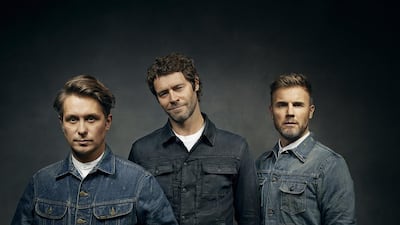It may be the Britpop battle of Blur and Oasis that has gone down in the history books, but the 1990s UK singles charts marked the battle ground of a far greater rivalry: Take That and East 17. The Manchester five-piece were frequently pitted against the East London quartet, who scored a comparable run of smash singles – the edgier Londoners charted 18 times in the 1990s, while Take That hit the top 40 15 times.
But posterity is a strange beast. Since reforming in 2006, Take That have been embraced as national heroes – their 2011 Progress Live tour is the biggest in British history, playing to 1.8 million people, while the parent album was the country’s second fastest-selling ever. They even won a Brit Award for Best British Group.
East 17, meanwhile, are reduced to scraps. In the UAE they’re known for performing annual Christmas-themed concerts at an Irish pub, while a recent concert in Dublin attracted just 30 people. But the story of Walthamstow’s finest is far from uncommon. As UAE visits from bands such as 5ive and Blue prove, boy bands simply don’t age well. It’s not hard to see why – ageing, balding men singing dated pop pastiche is an acquired taste. But it raises the question of how exactly Take That were able to return so very gloriously. Here are some theories.
Mums always liked them
The conventional boy-band marketing method is to present something that seems “rebellious” to a potential audience of teenage girls: baseball caps, tattoos, earrings and other terrible fashion statements that look ridiculous today. Take That, by contrast, were always such nice boys – one could imagine heyday Gary Barlow taking mum out for tea and cakes, and parents loved them right back. That means Take That have now recruited two decades of fans – the mums who always liked them, and the mums their once-teenage fans have become.
They made them wait ...
Lots of boy bands make frequent “comebacks”. And again, often following another squabbling line-up change. Take That got it right by making a clean cut. After bad-boy Robbie Williams quit in 1995, the band released just one more single and folded in 1996, amid scenes of sobbing teenage girls dominating the press. Take That followed the golden rule of showbiz by leaving the public wanting more.
... and got the return right
When, exactly a decade later, a reunion was announced (minus Robbie), it carried not the whiff of desperation, but triumph.
Momentum built with every subsequent tour, upping the ante until Williams – whose own solo career had fallen into doldrums – saw how well his former pals were doing and leapt back into the mix in 2010, to everyone’s advantage. Knowing that after 2011’s record-breaking Progress Tour it could get no bigger, Take That again called time, with a tour hiatus until this April. While Williams and Jason Orange quit in the interim, this year’s “III tour” assuaged fans who were worried Take That weren’t back for good, after all.
They recorded new music (which wasn’t all that bad)
From The Rolling Stones downwards, the world is full of big-name acts dining out on former glories for lucrative, globe-trotting tours. Take That deserve credit for continuing to produce new music – and lots of it, releasing a total of four news albums since reforming in 2005, all of which have topped the UK charts. The great reception to the last year's new album III and resulting tour also proved Williams's and Orange departure – shedding the band to the trio of Gary Barlow, Howard Donald and Mark Owen – hasn't dented any of the band's appeal.
The songs
While boy bands from The Monkees onwards have relied on songwriters to pen their hits, Take That songwriting, courtesy of chief writer and band leader Gary Barlow, has played a prominent role in establishing a consistent voice and recognisable melodic style – epitomised by 1995's landmark single Back for Good, which topped charts in 31 countries.
Take That perform at Dubai Media City Amphitheatre on Friday, doors 6pm, show 9pm, from Dh350. Limited tickets remain for a second concert at Hard Rock Cafe, Dubai Festival City on Saturday, from 7pm, Dh2,000. For more information, visit doneevents.com
rgarratt@thenational.ae

